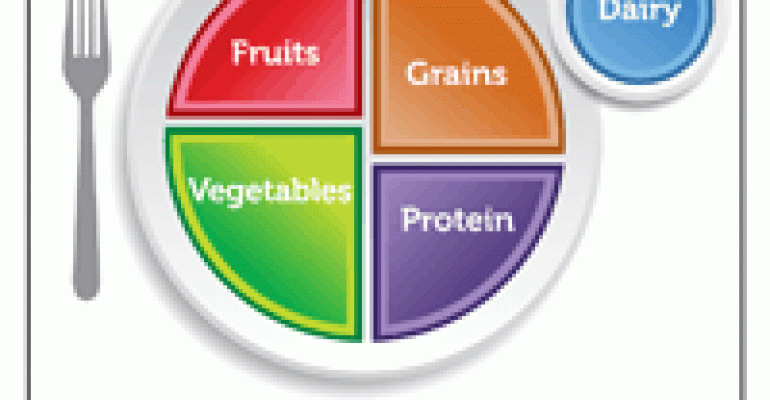
Naysayers gripe that the USDA’s new MyPlate dietary guidelines have more to do with politics than nutritional science. Others, including us, see them as something that can create moneymaking opportunities for operators. And customers? They want to eat healthfully, but not to the point where they’ll pay extra to do so.
The U.S. Department of Agriculture’s MyPlate push comes complete with a zippy new graphic and the personal endorsement of Michelle Obama. It’s meant to change the way Americans eat by encouraging them to cut back on animal proteins while consuming more fresh fruits and vegetables. Expect a lengthy informational PR campaign to come from the USDA about MyPlate as the agency and Mrs. Obama do their part to help improve the American diet.
Not everyone is buying into this approach. Already, Cenegenics, a preventive medicine institute, has come out with a competing nutritional diagram that’s significantly different than MyPlate. Dubbed the Cenegenics Food Diamond, it touts water, healthy fats, organic lean proteins, organic hormone-free dairy products and lots of beans and legumes as key diet ingredients not addressed by the oversimplified MyPlate diagram.
“MyPlate promotes a diet that says all carbohydrates are good, all fats are bad, all protein sources are nutritionally the same and all dairy is equal,” says Robert Willix, Cenegenics CMO. “It seems to support the notion that a no-fat or low-fat diet is the way to go when, in fact, that is precisely the reason 64 percent of American adults and over 30 percent of American children are overweight or morbidly obese.”
Restaurant consumers might prefer to eat the higher-end healthful items recommended by the Cenegenics people, but not many of them are willing to pay for that privilege. That’s what a new survey from market research firm NPD Group discovered as it gathered material for its “Consumers Define Healthy Eating When They Go Out To Eat” report.
NPD asked survey subjects if they would be willing to pay extra for healthful items at restaurants they visited often. Seventy percent of adults said they would not, 25 percent said they would be willing to pay “somewhat more” and a mere five percent said they would pay “a lot more.”
Young adults (ages 18-24) say they are more receptive to paying more for healthful food. Forty-four percent expect healthful items to be priced similarly to less healthful ones, but 41 percent say they would be willing to pay “somewhat more.” Fifteen percent expect to pay “a lot more.”
Of note, NPD found that more full-service restaurant patrons expect to pay the same amount for healthful items as less healthful ones, while fewer quick-service patrons are willing to do so.
“One of the key takeaways from the study results is that pricing of the healthy options needs to be consistent with pricing of other choices on the menu,” says Bonnie Riggs, NPD restaurant analyst, who authored this report. “The market for health today is growing and there is a good opportunity for operators who find a way to offer healthier options at lower price points.”
Your restaurant might not be able to meet the lofty nutritional standards proposed by the Cenegenics Food Diamond. But the MyPlate strategy looks doable for most full-service operators. Considering that the costly protein portion of a meal will be downsized when MyPlate guidelines are followed, there could be a net food cost reduction for restaurants that menu MyPlate-style meals.





